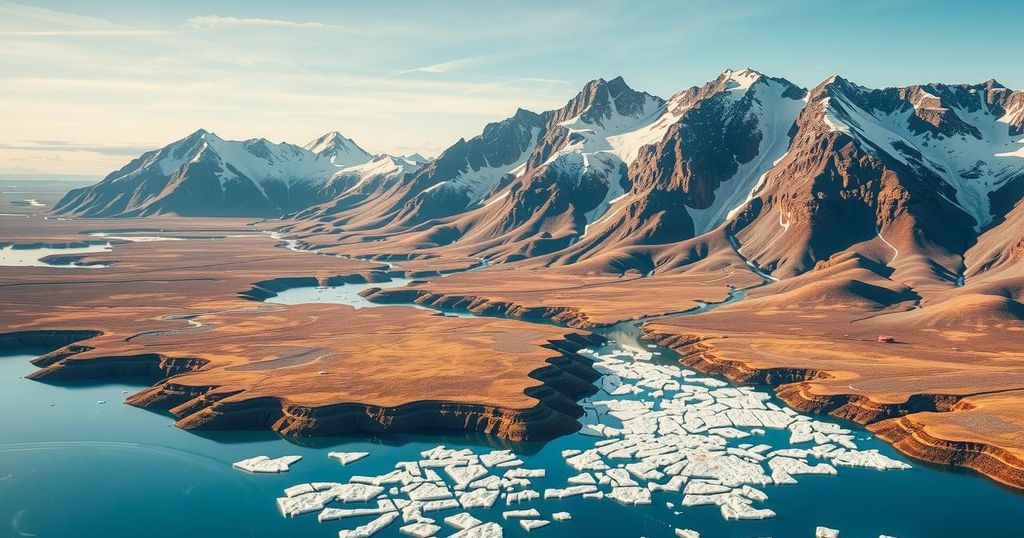The Geopolitical and Climatic Importance of Greenland’s Melting Ice

Greenland’s melting ice encapsulates critical resource potential and significant implications for global climate dynamics and geopolitics. The island’s ice is retreating rapidly, exposing valuable minerals and hydrocarbons while contributing to rising sea levels and altered weather patterns. Its position between the United States, Russia, and Europe enhances its geopolitical importance amid ongoing international competition.
Greenland, often considered remote and uninhabited, wields significant influence over global climate dynamics due to its ice masses and evolving geopolitical status. The island, known for its pristine landscapes, is increasingly acknowledged as central to geopolitical and geoeconomic strategies owing to climate change effects. President-elect Donald Trump’s previous interest in acquiring Greenland highlights its strategic importance as a semiautonomous territory of Denmark, which hosts a considerable U.S. military presence.
Furthermore, Greenland is likened to a giant refrigerator affecting global weather patterns, particularly as it warms at four times the global average. Abundant in rare earth minerals, natural gas, and oil reserves, the melting ice is revealing resources previously considered inaccessible. With the Danish government halting offshore oil development, the international interest in Greenland’s resources remains heightened, particularly as supply chains for critical materials are increasingly dominated by China.
Greenland’s ice mass is crucial not only for its resources but also as a potent indicator of climate change. Studies indicate that the ice cap holds enough water to raise sea levels by 24 feet if melted entirely. Alarmingly, it has lost an estimated 182 billion tons of ice annually since 1992, with the loss accelerating to 489 billion tons in 2019. As Mark Serreze from the National Snow and Ice Data Center remarks, Greenland will likely become an even more significant factor in climate discussions as its ice sheet continues to diminish.
In addition to influencing sea level rise, Greenland plays a role in the Atlantic Meridional Overturning Circulation (AMOC), which is essential for regulating global climate patterns. The influx of fresh water from melting Greenland ice is slowing the AMOC, raising concerns of a potential tipping point that could drastically alter weather patterns across Europe and North America.
The effects of Greenland’s transformations extend beyond geopolitics and resource management; they encapsulate significant climate implications. The substantial melting ice alters the albedo effect, transitioning from reflective ice to absorptive ocean, further exacerbating global warming. Moreover, its weather patterns have historically influenced major storms, exemplified by the trajectory change of Superstorm Sandy in 2012 due to Greenland’s influence.
Straddling the Arctic Circle, Greenland’s geographical positioning is critical within the broader context of international relations and climate change. Its unique landscapes and glacial features evoke awe among researchers and scientists who study its natural beauty and ecological significance. As the Arctic opens to new trade routes and shipping lanes, Greenland’s value as a geopolitical asset is further reinforced, making it an area of increasing global interest.
The significance of Greenland in contemporary geopolitics cannot be overstated. As the largest island in the world, it is experiencing profound changes due to climate warming, which is accelerating its melting ice sheets at an alarming rate. These alterations have critical implications for global sea levels and climate patterns. Greenland’s strategic location between major powers such as the United States, Russia, and Europe adds to its importance, making it a focal point in international discussions on resource allocation and planetary health. It is rich in rare earth minerals and hydrocarbon reserves, which are becoming more accessible due to melting ice, further enhancing its geopolitical allure.
In summary, Greenland stands at the nexus of climate change and geopolitics. As its ice continues to melt, it reveals massive natural resources while simultaneously posing significant challenges to global sea levels and weather patterns. The strategic interests surrounding this island are intensified by its changing climate and the geopolitical landscape, marking a pivotal moment in the global discourse on environmental issues and resource management. Understanding Greenland’s role will be crucial for addressing the multifaceted challenges posed by a warming planet.
Original Source: www.washingtonpost.com






